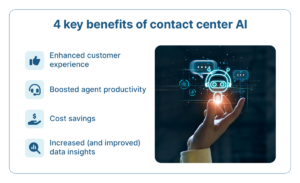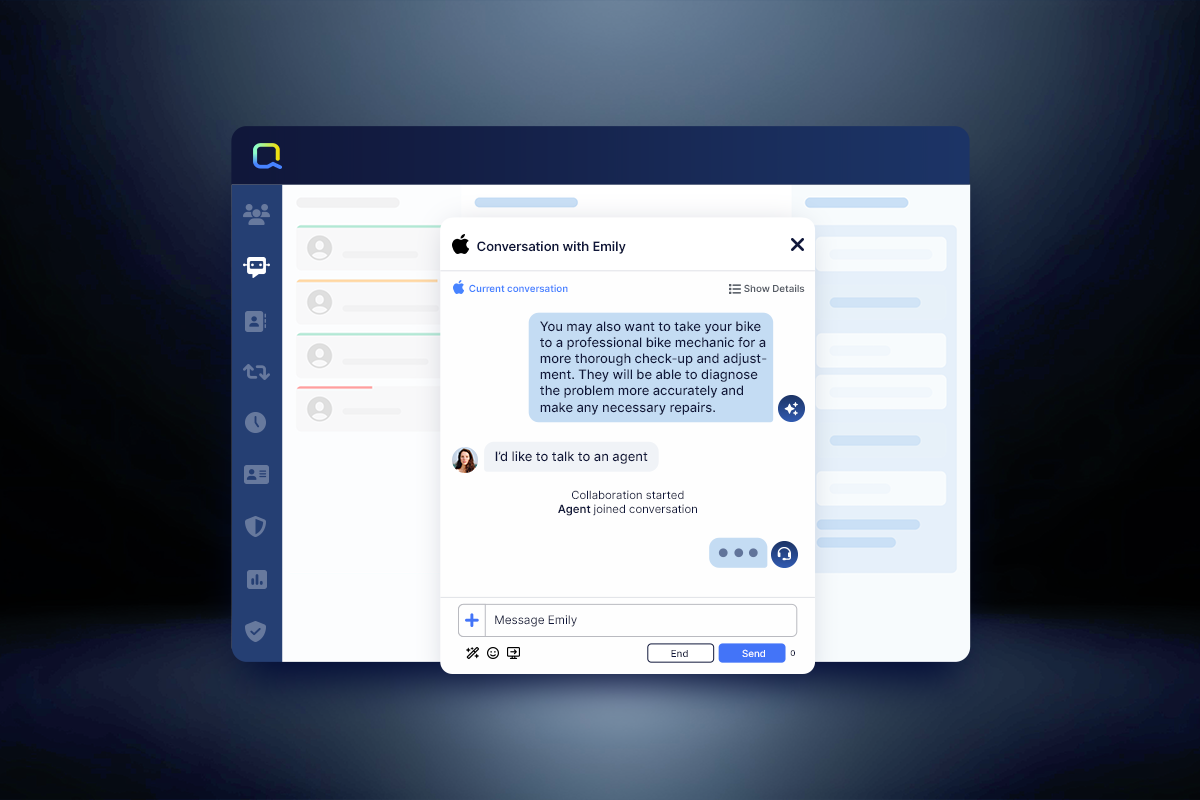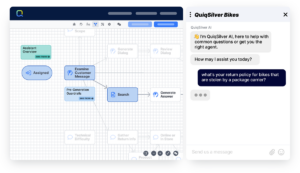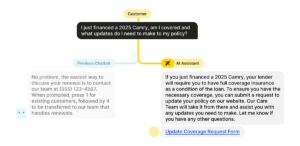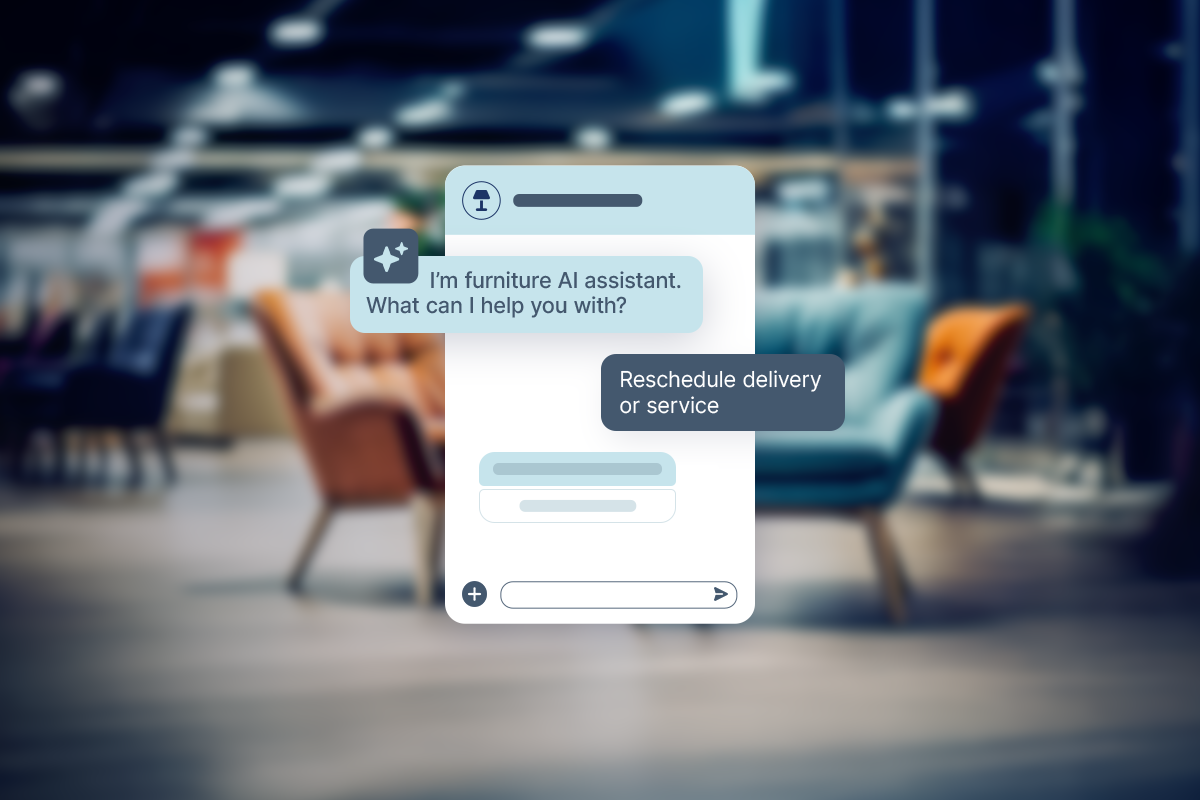KEY TAKEAWAYS
- Omnichannel messaging unifies communication channels (SMS, email, chat, social, etc.) into one seamless platform, ensuring context carries across every interaction.
- Unlike multichannel (which focuses on availability), omnichannel prioritizes consistency so customers never have to repeat themselves when switching channels.
- Benefits include smoother customer experiences, stronger personalization, faster resolutions through AI automation, and more efficient team workflows.
- A successful strategy focuses on knowing customer journeys, integrating key channels, unifying data, maintaining a consistent voice, and measuring results.
- Choosing the right platform means ensuring broad channel coverage, strong CRM integrations, scalability, analytics, and compliance with data security standards.
- Tools like Quiq make omnichannel adoption easier with AI automation, CRM integrations, and scalability—helping businesses deliver better experiences at scale.
Effortless communication is the backbone of today’s leading businesses, especially in industries like e-commerce and retail. Customers expect quick, personalized interactions that fit their needs and, more importantly, their preferences and busy schedules. That’s where omnichannel messaging comes in—a game-changer for businesses looking to nurture meaningful customer relationships, solve queries faster, and deliver exceptional experiences across all touchpoints.
What does omnichannel messaging mean, and how can it reshape how companies connect with their customers? This comprehensive guide explores its definition, benefits, strategies, and touches on how Quiq’s omnichannel messaging platform can turn it into a competitive edge.
What is Omnichannel Messaging?
At its core, omnichannel messaging is a strategy that integrates communication channels, including SMS, email, live web chat, social media, and more, into a unified platform. Unlike multichannel messaging, where interactions across channels are siloed, omnichannel messaging ensures customer interactions are seamless, connected, and context-aware no matter which channel they use or move to while trying to resolve an issue.
For example, a customer might start a conversation on Instagram Messenger, continue it via email, and then complete their inquiry over SMS, all while a single thread of past messages and intent follows them. Omnichannel messaging keeps everything cohesive, eliminating repetition or confusion during customer interactions.
Omnichannel messaging has become a vital tool for creating exceptional customer experiences, offering businesses a way to engage customers directly on their preferred platforms while maintaining a consistent and unified voice.
Omnichannel vs Multichannel: Key Differences
At first glance, omnichannel and multichannel messaging might sound like the same thing, as they both involve using multiple communication channels to reach customers. But the way they connect those channels makes all the difference.
- Multichannel messaging means offering customers different ways to interact with your brand (SMS, email, live chat, social media, etc.). Each channel operates independently, and the customer experience can vary depending on where the interaction takes place. For example, a conversation started in a web chat might not carry over to an SMS thread.
- Omnichannel messaging takes things a step further by unifying all channels into a single, continuous experience. No matter where the conversation starts or shifts, the context follows the customer. An AI agent can see the full conversation history across SMS, chat, email, and even social platforms, allowing for smoother handoffs and more personalized interactions.
The bottom line: multichannel is about availability, while omnichannel is about consistency. A multichannel strategy ensures customers can reach you where they want, but an omnichannel strategy ensures they never have to repeat themselves or start over when they switch channels.
Key Characteristics and Benefits of Omnichannel Messaging
With customer expectations soaring and new channels seeming to pop up each day, omnichannel messaging offers businesses tangible advantages that impact everything from customer satisfaction to long-term loyalty.
1. Seamless Customer Experience
The greatest strength of omnichannel messaging lies in providing a frictionless experience for customers.
- By unifying communication across platforms, businesses ensure conversations are not interrupted, even when customers switch from one platform to another.
- Integration with customer support tools, such as CRMs, centralizes interactions, offering teams a full view of previous conversations. This leads to higher clarity and faster resolutions.
Imagine a shopper reaching out via web chat with a query about your e-commerce selection. Later, when they message again through WhatsApp, your support team already knows their query history, saving time for both the customer and your team.
2. Personalized Interactions
Personalization has become the gold standard for successful customer engagement and customer retention. Omnichannel messaging takes it to the next level by utilizing collected customer data to craft highly relevant and timely messages.
- Tailor communications based on customer preferences, buying habits, or interaction history. For example, send product suggestions and reminders relevant to their recent purchases.
- Maintain message context across channels to avoid frustrating scenarios where customers have to repeat their queries.
This kind of personalization doesn’t just benefit customer satisfaction; it also improves lead conversion and builds layers of trust.
3. Enhanced Customer Satisfaction
Customer satisfaction relies heavily on businesses’ ability to respond quickly and resolve issues efficiently.
- With omnichannel messaging, faster response times are possible through features like AI automation, smart ticket routing, and quick action suggestions for human agents.
- Seamless resolutions across any platform create a lasting impression of reliability and commitment toward customer care, further building loyalty.
When customers feel heard and valued, they are more likely to become repeat buyers and brand advocates.
4. Streamlined Communication
Managing numerous communication channels often feels overwhelming for customer service teams. Omnichannel platforms rectify this chaos.
- By centralizing interactions on a single platform, teams simplify their workflows and enhance communication efficiency.
- AI-powered automation handles repetitive tasks, like sending order confirmations or appointment reminders, enabling your agents to focus on higher-value conversations.
Efficiency leads to reduced operational costs without sacrificing quality service, something no forward-thinking business can afford to overlook.
5. Improved Customer Retention
Research consistently shows that satisfied customers are more likely to stay with a brand.
- Omnichannel messaging fosters emotional loyalty by delivering consistent, valuable experiences.
- Proactive engagement, such as personalized birthday discounts sent via the customer’s favorite channel, keeps your brand top of mind.
Over time, this combination of trust and tailored care translates to greater lifetime customer value.
6. Consistent Brand Voice
Your brand’s voice is the essence of its identity. Omnichannel messaging ensures it remains unified across all platforms.
- Whether communicating on Instagram, through email, or via SMS, the tone, style, and messaging are consistent.
- This consistency reinforces your brand identity, making it recognizable and reliable.
Large-scale enterprises and startups can harness this benefit to build a stronger market presence and leave no room for mixed business messaging.
7. Competitive Advantage
Adopting omnichannel messaging separates your business from competitors still relying on siloed, fragmented communication strategies.
- A seamless, personalized approach encourages stronger customer relationships and establishes your business as innovative and customer-focused.
- Businesses leveraging platforms with real-time solutions and AI tools are seen as more responsive and resourceful, which proves to be a clear differentiation in today’s crowded market.
For example, incorporating communication options like WhatsApp in regions where SMS usage is limited makes your business accessible to untapped customer bases.
How to Create an Omnichannel Messaging Strategy
An effective omnichannel strategy is less about being on every channel and more about creating seamless, connected experiences. Here’s how to get started:
- Know Your Customers: Map their journey and identify which channels they use most.
- Integrate Key Channels: Focus on the ones that matter and connect them so context carries over.
- Unify Data: Centralize customer information so teams see the full conversation history.
- Stay Consistent: Use a unified voice, tone, and brand style across all touchpoints.
- Measure & Improve: Track KPIs like CSAT and response times to refine your approach.
A successful omnichannel strategy prioritizes connection and consistency, ensuring customers never feel like they’re starting over when they switch channels.
How to Choose an Omnichannel Messaging Platform
The right omnichannel messaging platform ensures your strategy feels seamless rather than fragmented. Focus on these essentials:
- Channel coverage: Supports the channels your customers use most.
- Integrations: Connects with your CRM and support tools for unified data.
- Ease of use: Simple for teams to adopt with automation and clear dashboards.
- Scalability: Grows with your business and new channel needs.
- Analytics: Delivers insights on response times, CSAT, and conversions.
- Security: Meets industry compliance and data protection standards.
Our biggest tip is to choose a platform that not only offers features but also unifies channels, data, and teams to deliver a truly seamless customer experience.
Tackle omnichannel messaging with Quiq
Creating an omnichannel messaging strategy is easier with modern tools like Quiq. Designed to integrate seamlessly across your ecosystem, Quiq offers several standout features:
- Easy integration with platforms like Salesforce, SAP, and Shopify, uniting customer touchpoints under one interface.
- AI-powered agents and automation to handle repetitive queries and speed up response times while improving accuracy.
- Unmatched scalability for growing businesses ready to expand to more channels without increasing complexity.
With Quiq, businesses access a world-class omnichannel communication platform that simplifies messaging while amplifying customer satisfaction.
FAQs
What’s the difference between omnichannel and multichannel messaging?
Multichannel messaging means being available on different platforms (SMS, email, chat, social, etc.), but each channel functions independently. Omnichannel messaging connects those channels into one continuous experience, so context and conversation history follow the customer wherever they go.
What channels should I include in my omnichannel strategy?
It depends on your customers. Our advice would be to start by mapping their journey and identifying the platforms they use most (e.g., SMS, WhatsApp, live chat, or social messaging). Focus on connecting those first to maximize impact.
How does agentic AI fit into omnichannel messaging?
Agentic AI enhances omnichannel platforms by automating common tasks, offering smart routing, and personalizing responses at scale. This reduces wait times and frees up human agents to focus on complex or high-value interactions.
How can I measure the success of an omnichannel messaging strategy?
Key metrics include customer satisfaction scores (CSAT), Net Promoter Score (NPS), response times, and customer retention rates. Improved consistency and fewer customer complaints are also strong indicators of success.













